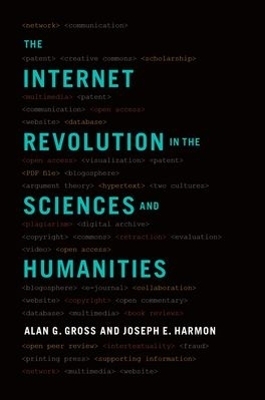
The Internet Revolution in the Sciences and Humanities
Oxford University Press Inc (Verlag)
978-0-19-046593-3 (ISBN)
The Internet Revolution in the Sciences and Humanities takes a new look at C.P. Snow's distinction between the two cultures, a distinction that provides the driving force for a book that contends that the Internet revolution has sown the seeds for transformative changes in both the sciences and the humanities. It is because of this common situation that the humanities can learn from the sciences, as well as the sciences from the humanities, in matters central to both: generating, evaluating, and communicating knowledge on the Internet. In a succession of chapters, the authors deal with the state of the art in web-based journal articles and books, web sites, peer review, and post-publication review. In the final chapter, they address the obstacles the academy and scientific organizations face in taking full advantage of the Internet: outmoded tenure and promotion procedures, the cost of open access, and restrictive patent and copyright law. They also argue that overcoming these obstacles does not require revolutionary institutional change. In their view, change must be incremental, making use of the powers and prerogatives scientific and academic organizations already have.
Alan G. Gross work is firmly grounded in the humanities, having been trained as a Shakespeare scholar at Princeton under Gerald Eades Bentley. In a long career, he has been an English professor at Wayne State, a Dean at Purdue-Calumet, and professor of Communication Studies at the University of Minnesota. In the last quarter-century, he has written and co-written a steady stream of major-press books on academic communication. Joseph E. Harmon works as a science writer, editor, and manager at Argonne National Laboratory. He is the coauthor with Alan Gross of Communicating Science: The Scientific Article from the 17th Century to the Present, The Scientific Literature: A Guided Tour, The Craft of Scientific Communication, and Science from Sight to Insight: How Scientists Illustrate Meaning.
Table of Contents
About the Companion Website
Chapter 1: The Internet and the Two Cultures
Ideal Types
The Scientific Culture and Scientist as Ideal Type
The Humanistic Culture and Humanist as Ideal Type
The Sciences and Humanities Transformed
The Book Itself
The Audience
Chapter 2: The Scientific Article: What's New
Revolution or Evolution?
A Survey of the Web Article
Increasing Accessibility
The Changing Nature of Authorship
Coping with Complexity
Increasing Inter- and Intra-textuality
Including Reader Comments and Reader Statistics
Enhancing Visualization
Internet Visualization and the Science of Shape
Birth of a Science of Shape
The Mathematical Visualization of Shape
Science of Shape and the Internet
Conclusion
Chapter 3: The Internet Humanities Essay: Seeing and Hearing Anew
Historians See Anew
Photographs as Historical Evidence
Art as Historical Evidence
Reinterpreting the Civil War: The Role of Visualization
Meeting the Challenge of Urban History: A Multi-Media Los Angeles
Re-imagining the Roman Forum: Vision as Hypothesis
Musicians See and Hear Anew
Film Scholars See Anew
Conclusion
Chapter 4: Archival Web Sites in the Humanities and Sciences
Web Sites That Provide Resources for Scholarship
Web Sites That Store Data for Scientific Research
Web Sites That Store Scientific or Scholarly Papers
Web Sites That Create Knowledge Through Volunteer Participation
Web Sites That Codify Existing Knowledge
Conclusion
Chapter 5: Evaluation before Publication: Opening up Peer Review
The Case for and against Peer Review
Argument Theory and Peer Review
Theory Application
Open Internet Peer Review in the Sciences
Open Internet Peer Review in the Humanities
Peer Sourcing: The Wave of the Future?
Conclusion
Chapter 6: Evaluation after Publication: Setting the Record Straight
Science Blogs
What Science Blogs Reveal
How Science Blogs Work
Humanities Post-Peer Review
Post-Publication Peer Review: The Article
Post-Publication Peer Review: The Book
Conclusion
Chapter 7: Overcoming the Obstacles to Internet Exploitation
The Opportunities
Gated Access: The First Obstacle
Current Tenure Rules: The Second Obstacle
Digital Preservation: The Third Obstacle
Patents and Copyright: The Fourth Obstacle
Freedom of Information: The Fifth Obstacle
A Path Forward
| Erscheinungsdatum | 25.05.2016 |
|---|---|
| Verlagsort | New York |
| Sprache | englisch |
| Maße | 234 x 155 mm |
| Gewicht | 363 g |
| Themenwelt | Sachbuch/Ratgeber ► Natur / Technik |
| Mathematik / Informatik ► Informatik ► Theorie / Studium | |
| Mathematik / Informatik ► Informatik ► Web / Internet | |
| Naturwissenschaften | |
| Sozialwissenschaften ► Kommunikation / Medien ► Kommunikationswissenschaft | |
| Wirtschaft ► Betriebswirtschaft / Management ► Wirtschaftsinformatik | |
| ISBN-10 | 0-19-046593-X / 019046593X |
| ISBN-13 | 978-0-19-046593-3 / 9780190465933 |
| Zustand | Neuware |
| Haben Sie eine Frage zum Produkt? |
aus dem Bereich


